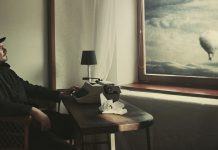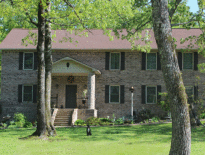On the 22nd of November 1963, global attention was captured by the tragic assassination of American President J.F. Kennedy. On the same day, the death of one of the most influential Christians of the 20th century, the British writer and apologist C.S. Lewis, went almost unnoticed.
The past half century has witnessed an increase in Lewis’s popularity among children and young people through the phenomenal success of his books, The Chronicles of Narnia. And, through the impact of two of his best known books, Mere Christianity and Surprised by Joy, many adults have had their faith strengthened. The following interview was conducted at Lewis’s memorial home in Kilns, near Oxford, with Dr. Deborah Higgens, professor of literature at Southern Adventist University, Collegedale, Tennessee, an expert on Lewis’s life and work, and director of the C.S. Lewis Study Center, hosted in this historic house.
AB: When and how did you become interested in the life and writings of C.S. Lewis?
DH: I was already an adult when I returned to college to get my degree in English and religion. The teacher assigned us to read a book called Mere Christianity by C.S. Lewis. We had to review each chapter and write down our personal reactions. I fell in love with C.S. Lewis.
AB: Was this the first time you read it?
DH: Yes. Many people read The Chronicles of Narnia as children, but I had never heard of them.
I have vivid memories of its artistic images and how much this book meant to me. I also see this in the visitors coming to see the house: how much their relationship and walk with Christ was deepened by their reading Mere Christianity.
It was only after Mere Christianity that I read The Chronicles of Narnia. I started reading everything I could find by C.S. Lewis. Whenever I had the opportunity to choose a subject in class at Columbia Union College, I wrote about Lewis’ life and works. The teachers remember very well that I had become a fanatic when it came to Lewis.
AB: Would you share with us some reasons for your passion for the works and life of C.S. Lewis?
DH: There are many reasons. I think it’s the combination of religion, imagination and literature. He uses them all in a very special way. In other authors we see parts of these things, but we do not perceive them in the way he merged them. I think that if I were to look for the roots of this inclination of his, I would reach his childhood, when his mother taught him Latin at the age of six. He had a vast literary horizon, from which he was always inspired. He read in Old English and Old Scandinavian German. We can find this literature in his writings. Most people don’t see it because they don’t know that literature. It is, however, reflected in his writing. Then we see the religious elements. He was a Christian, and the Christian elements are present, although they are not always openly presented—only sometimes. Everything blends beautifully. It makes me think of a tapestry.
AB: How did this passion materialise in your life?
DH: For my master’s program I wrote two papers, one on Lewis. In 1994 I started teaching a course on Lewis. Students were required to read thirteen books.
In 1994, when I met you at Newbold College, it was the first time I had visited this house at the end of the conference. In 2002 I attended an Oxbridge conference held by the C.S. Lewis Foundation. The foundation is based in Redlands, California, and owns this home. Later, in 2007, when I was writing my doctoral dissertation, the C.S. Lewis Foundation offered me the opportunity to become a senior member of the resident scholarship program.
In the meantime, they had restored the house. The restoration lasted nine years. In 2006, the house was transformed into an official center for the study of C.S. Lewis’ life and work. I was here from January to June 2007. Here is where I wrote one chapter a month on my doctoral dissertation. I’ve always wanted to come back and run this program, and that’s what I’m doing now.
AB: Why is this house so special that you wanted to come back here?
DH: C.S. Lewis bought the house in 1930. It had been built in 1922. There were two large brick-burning kilns on the property, which were shaped like a hive. They were much older than the house, were no longer in use in Lewis’s time, and have since been demolished. The name of the property comes from them, ”kiln” meaning “oven”. C.S. Lewis loved nature, and many of his writings reflect this, especially children’s books or adult fiction. He liked to retreat, and this area was quiet at the time. There is a lake and what is now a nature reserve.
This house is special because Lewis wrote many of his books here. Lewis was a professor at Oxford, Magdalen College. He had an apartment there, but he came here on the weekends, he came at noon, he came on vacation. He often planted trees behind the lake. He enjoyed gardening. He liked to walk. This house has become special because each window on one side of it overlooks the lake and the beautiful nature surrounding it. Lewis had a desk by the living room window where he could see the lake. He used to write overlooking the lake. It helped that he could retreat, think, reflect, and relax.
AB: What were the defining moments in Lewis’ spiritual journey?
DH: His grandfather had been a pastor, so he was raised in the Anglican church. During his studies, Lewis became an atheist. I think it was all triggered by his mother’s death. He was a child and he had prayed for her to live. He believed that God would work a miracle.
God did not intervene and that removed him or began to take him away from God. Later, during his studies and especially when he took private lessons, when he was around 16, he became an atheist and discovered the power of reason and argument. I’m talking about academic argument, not quarrel. He was an expert in the art of debate. No one could beat him.
While in boarding school at Magdalen College, he befriended J.R.R. Tolkien. They often met with several writers and chose the name The Inklings. They met once a week at the Eagle and Child Cafe. During one of these meetings they talked about Christianity. C.S. Lewis was surrounded by Christians. They went for a walk on Addison Alley. There is a beautiful path in the park at Magdalen College. These people walked late in the evening and talked about Christianity and myths. C.S. Lewis argued about how beautiful these myths were, but commented that the myth of Christianity was not as beautiful as others, it was not as interesting.
Tolkien replied, “That’s because it’s true. It’s something real. Took place. That’s why it doesn’t have so many embellishments.”
This led Lewis to believe that Christianity was a “real myth.” I guess some people don’t agree with this phrase, but that’s how he saw it, because that’s how his mind worked. It was the moment he converted to theism; he came to believe thought there is a God.
Shortly afterwards Lewis was in a motorcycle side-car. He did not have a driver’s license. His brother, Major Warren Lewis, had a motorcycle with a side-car, so he rode in the side-car. They went to Whipsnade Zoo here in Oxford. He said he left as a non-Christian and ended up there as a Christian. That was the experience of his conversion, which took place in the early 1930s. Ten years later, the war began. I mentioned Mere Christianity, which was initially developed as radio programs held at the BBC during the war. He had often gone to speak to military pilots as well. When I read his works, I always see the two wars that intertwine in absolutely everything. The devil is always associated with war in his works.
AB: What is the portrait of C.S. Lewis, in a nutshell?
DH: Lewis was a very humble man. He is sometimes said to be a bit elitist, but, because I lived here and talked to people who knew him, I can’t see him as elitist. He loved debates, he was a person you didn’t want to argue with. He strongly defended Christianity because he had strong arguments.
Often, the apologetic dimension is intertwined in autobiographical works, such as The Problem of Pain, About Miracles, The Four Loves and Surprised by Joy, the latter being an autobiography of the first period of his life, in which he talks about his conversion.
AB: The best known are his works of fiction. Why?
DH: Yes, The Chronicles of Narnia are very popular, especially in the United States. These works of fiction are meant to induce a longing for God. I think that was their goal. In fact, I shouldn’t say it was their goal. I think Lewis wrote for the sake of writing. I don’t think he wrote with that goal in mind. Maybe that makes it convincing, the fact that it’s authentic. They don’t necessarily want to convince.
AB: What is your favourite passage from the writings of C.S. Lewis?
DH: A passage from The Voyage of the Dawn Treader. At the end of the book, the children reach the end of their journey.
Only between them and the foot of the sky was something so white on the green grass that even with their eagle eyes they could barely look in it. They got near and found that it was a Lamb.
“Come and have breakfast,” said the Lamb in its sweet, milky voice.
Then they noticed for the first time that there was a fire lit on the grass and fish roasting on it. They sat down and ate the fish, hungry now for the first time for many days. And it was the most delicious food they had ever tasted.
“Please, Lamb,” said Lucy, “is this the way to Aslan’s country?”
“Not for you,” said the Lamb. “For you the door into Aslan’s country is from your own world.”
“What!” said Edmund. “Is there a way into Aslan’s country from our world too?”
“There is a way into my country from all the worlds,” said the Lamb; but as he spoke his snowy white flushed into tawny gold and his size changed and he was Aslan himself, towering above them and scattering light from his mane.
“Oh, Aslan,” said Lucy. “Will you tell us how to get into your country from our world?”
“I shall be telling you all the time,” said Aslan. “But I will not tell you how long or short the way will be; only that it lies across a river. But do not fear that, for I am the great Bridge Builder. And now come; I will open the door in the sky and send you to your own land.”
Christians certainly see the connections. Not only do they see them, but they have immense joy when they realise what all the symbols in these events are, even the smallest details. In the soul of any reader awakens the longing for God, for salvation.

















